
Combining two trailers into one home
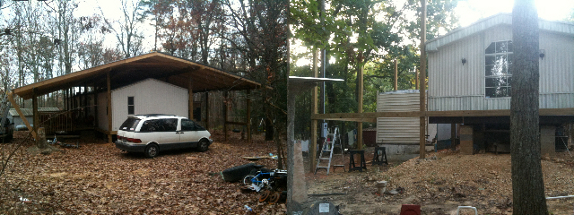
 Lindsey and her husband Keith
live in a "crazy, cobbled-together,
split-level
mobile home" in northeast Alabama with their five children. "We
also have another baby due in February 2013, and we hope to have
several more before my child-bearing days are over," Lindsey
added. At 1,680 square feet, personal space in their
two-trailer combo clocks in below the average size of even a 1950s-era
home, but they find the advantages of trailer life outweigh the
disadvantages.
Lindsey and her husband Keith
live in a "crazy, cobbled-together,
split-level
mobile home" in northeast Alabama with their five children. "We
also have another baby due in February 2013, and we hope to have
several more before my child-bearing days are over," Lindsey
added. At 1,680 square feet, personal space in their
two-trailer combo clocks in below the average size of even a 1950s-era
home, but they find the advantages of trailer life outweigh the
disadvantages.
"We moved from western
Washington state to Georgia in 2002 with our
7-month-old firstborn, hoping to find a place where we could live on
one income and buy some land," said Lindsey. "Being willing to
live in a trailer certainly enables us to live the way we do, on one
income with Mom homeschooling the kids. That was our priority and
we were willing to do just about anything to achieve that."
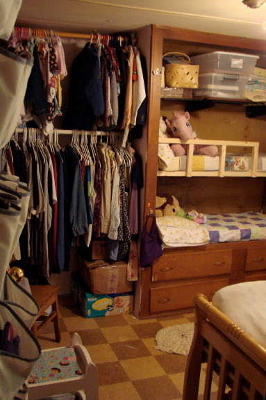 "When we found a real estate
ad for 11 acres with a 'house' for $40,000
we immediately made an appointment to see it," Lindsey
remembered. The house turned out to be a 10-by-40-foot trailer
from the early 1960s with a "poorly-built addition of about the same
size," which they later tore down.
"When we found a real estate
ad for 11 acres with a 'house' for $40,000
we immediately made an appointment to see it," Lindsey
remembered. The house turned out to be a 10-by-40-foot trailer
from the early 1960s with a "poorly-built addition of about the same
size," which they later tore down.
"Our plan was to live in
the trailer/addition combo for 5 to 10 years
while saving money to build a more suitable house," Lindsey said.
"There was always a sort of 'ew, a trailer' attitude between us,
although we didn't look down on other folks who lived in them. We
just figured we'd need something sturdier and bigger for the family we
were hoping to grow."
But the trailer slowly won the family over. "The little trailer
had a really good design that took advantage of
every bit of available space in a relatively attractive way," Lindsey
explained. "Well, we
liked it anyway. And my husband always admired how well-designed
things were for such a small space."
Perhaps because of the
positive aspects of the original trailer, the
couple opted to increase their living area by adding a second trailer,
purchased for $7,500 and moved and installed for another $3,000.
"Our second trailer is a 1998 model 16x80. It's not as well
planned as the older trailer. I think it tries too hard not to
look like a trailer."
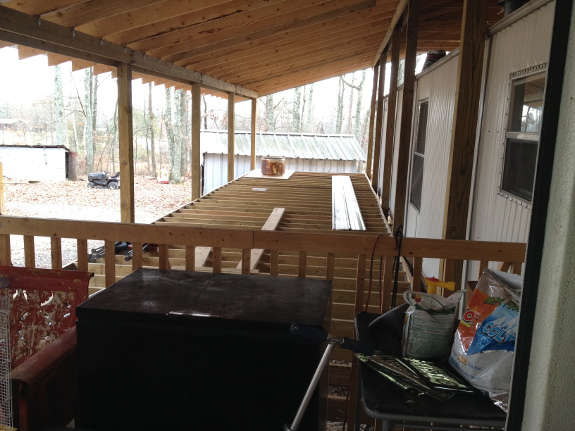
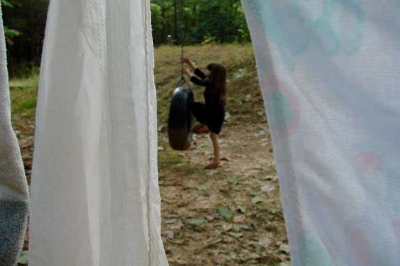 With the two trailers butting
up against each other, the obvious next
step was to turn them into a single structure with a joined roof.
"The roof is pretty colossal and ended up costing a lot more time,
money, and effort than we initially imagined," Lindsey said, adding
that the final price tag for the roof alone was close to $9,500.
"So we probably could have purchased a place with a more typical home
for the money we've spent, but we wouldn't have the space we have now,
we wouldn't have a unique home (which we like!), and we would still be
in debt instead of having spent the money when we had it, a little (and
sometimes a lot) at a time."
With the two trailers butting
up against each other, the obvious next
step was to turn them into a single structure with a joined roof.
"The roof is pretty colossal and ended up costing a lot more time,
money, and effort than we initially imagined," Lindsey said, adding
that the final price tag for the roof alone was close to $9,500.
"So we probably could have purchased a place with a more typical home
for the money we've spent, but we wouldn't have the space we have now,
we wouldn't have a unique home (which we like!), and we would still be
in debt instead of having spent the money when we had it, a little (and
sometimes a lot) at a time."
Although Lindsey's
trailers are not as well-insulated as their
neighbors' stick-built houses, the unique roof (and nearby trees) do a
great job deflecting summer heat. "Our pavilion-style roof makes
it a lot cooler in our house
than it would be with a conventional roof," Lindsey said. "We
have friends with a trailer almost identical to our newer one.
They have zero trees and the original roof and they spend a fortune on
cooling it all summer long—for 4 or 5 months—because it just doesn't
keep its cool like ours does."
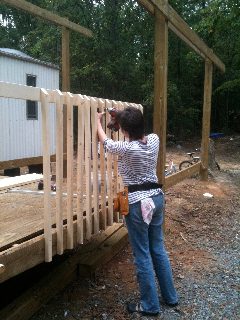 I was fascinated by the way
Lindsey's attitude toward her trailer
changed over the years. "It's been a while in coming but I think
we all like our home," she said. "It's
different, more than a little counter-cultural, so to speak, and that's
how we like to roll.
I was fascinated by the way
Lindsey's attitude toward her trailer
changed over the years. "It's been a while in coming but I think
we all like our home," she said. "It's
different, more than a little counter-cultural, so to speak, and that's
how we like to roll.
"Most people hear about
our house and look like they want to move a few
feet further away from me, but once they see it or hear more about it
they tend to think it's actually kind of cool, if not something they'd
ever choose for themselves." She concluded: "A few years before
we finished paying off our land, we realized that
we're actually not 'too good' to live in a trailer, possibly forever."
To read more about
living in a trailer with kids, check out the rest of Lindsey's profile
in Trailersteading.
| This post is part of our Trailersteading lunchtime series.
Read all of the entries: |
Want more in-depth information? Browse through our books.
Or explore more posts by date or by subject.
About us: Anna Hess and Mark Hamilton spent over a decade living self-sufficiently in the mountains of Virginia before moving north to start over from scratch in the foothills of Ohio. They've experimented with permaculture, no-till gardening, trailersteading, home-based microbusinesses and much more, writing about their adventures in both blogs and books.
Want to be notified when new comments are posted on this page? Click on the RSS button after you add a comment to subscribe to the comment feed, or simply check the box beside "email replies to me" while writing your comment.
